If you look on a board game shelf, how many games will you see with actions based on collaboration, stewardship, generosity, and gratitude? Most likely, you’ll find mechanics like attacking, stealing, and backstabbing. Indigenous communities looking to facilitate intergenerational gameplay are thus hard-pressed to find options that reinforce their teachings. In response, communities are developing their own games for passing on teachings in many forms. As espoused by game designer Brenda Romero, the mechanic is the message. And the messages in the board game The Gift of Food—inspired by collaborative game development with Indigenous communities working with the Northwest Indian College—produce culturally responsive gameplay, meaning gameplay that is drawn from and that uplifts the cultures involved.
The Gift of Food is an ideal example of how culturally responsive board games can function as important pathways for passing on Indigenous ways of knowing, as learning and reinforcing community teachings is built into the game’s mechanics.1 The Gift of Food was developed by and for Pacific Northwest Native communities as a way of passing on cultural teachings about how and where to gather foods and medicines in different ecosystems and during different seasons. I was honored to be invited into the project as a designer and writer based on recommendations from members of the Northwest Indian Storytellers Association with whom I collaborated on the social impact game Survivance.
Although The Gift of Food is currently only circulated within Pacific Northwest Native communities, the overarching design is being shared so that other Indigenous communities and game developer allies who involve Indigenous collaborators will consider making board games due to how successful The Gift of Food has been in bringing community knowledge to community members of various ages. I welcome adaptation of the overall design with attention to mechanics that support teachings in the hopes of other Indigenous communities revitalizing relational knowledge about land, water, food, and medicinal plants across generations. In this essay, I will outline these overarching aspects of the game’s design process to show how board games can serve as important tools for passing on cultural teachings, especially within Indigenous communities.
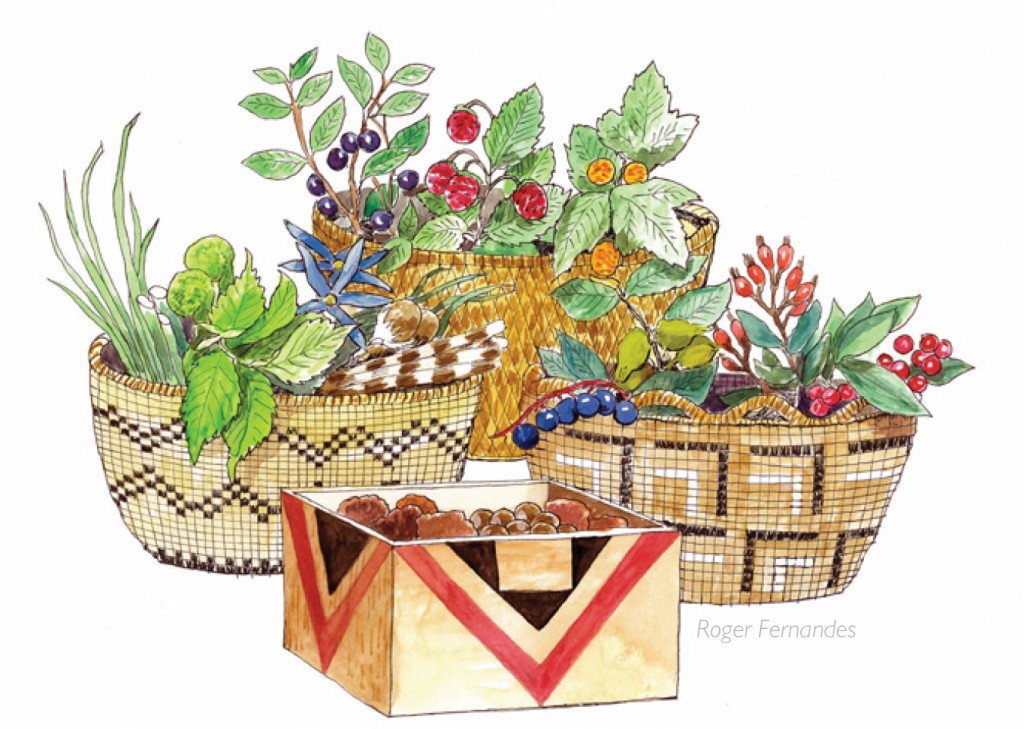
Gameplay
In this game, the design is paramount to creating a situation in which the player must retain knowledge to play the game successfully. For example, players pull scenario cards with background art that directly mirrors the game’s board. They have to look closely or recall from memory to find the matching patterns of the land or water related to the food or medicine they are hoping to acquire. Thus, players begin to think about foods and medicinal plants in relation to the ecosystems that support them and activate Indigenous relational worldview—the understanding that all life is connected, which in turn creates a reciprocal relationship with place.2 Another way in which the game design facilitates the transmission of cultural teachings is how players must occasionally read traditional and historical stories included in the guide book—a rule book that also includes stories, knowledge about eco-systems, foods, and medicines, and a language journal—as part of gameplay. At other times, stories must be recalled from memory, such as during Winter scenarios, in honor of recognizing Winter as the storytelling season. In this way, the design actively passes on the stories themselves as well as teachings around storytelling protocol.
Gameplay sessions observed during various phases of playtesting during iterative development showed players retained knowledge about foods, medicinal plants, and land, and activated teachings about cultural values including collaboration, stewardship, gratitude, and generosity. Our observations were based on seeing players make different or repeat choices when replaying the game and making comments about remembering knowledge from a previous play session.
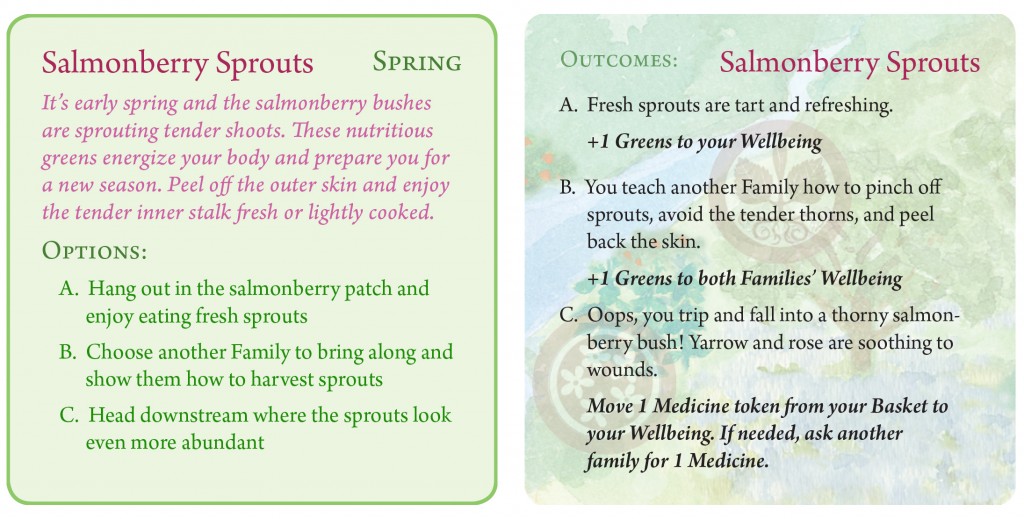
Players also influence the gameplay experience by reinforcing or challenging its teachings. Humor on the part of players was an ongoing way in which teachings were emphasized. In one instance, we observed one player holding onto food gift tokens in their basket mat and not sharing or trading with other players. After the game was over, other players teased that they weren’t going to share their real food during the community feast with that player because they hadn’t been generous during the game. Thus, gameplay was seen as a way to safely act out personal choices. However, these decisions could impact how people in the community received individuals and reinforced teachings with them even after gameplay, often by using playful humor to remind players of their actions and how these did or did not align with the community’s values.
In more elaborate instances of gameplay, players can self-determine teachings in The Gift of Food. Namely, Indigenous languages are reinforced in the back of the guide book by including blank pages for players to write in the food and medicine names in their own language. Thus, communities can adapt the game for language revitalization and continuance as a layer that interrelates with traditional knowledge. Overall, our hope as a development team is that communities will customize other board games based on The Gift of Food to meet their specific needs.
Collaborative Development
Before moving forward with describing this work that may inspire the design and development of board games that draw on Indigenous ways of knowing, it is important to establish that games with Indigenous content should ideally involve collaboration with and content contribution by Indigenous community members. The development process recognizes communities and developers as equal contributors. Usually, I am invited by a community to develop a game, rather than me approaching a community first. Community members should be directly involved in the process of adapting their culture to a game, otherwise a game may include misrepresentation or appropriation. Games that represent fictional Indigenous communities could also benefit from involving Indigenous collaborators, but in some cases are thoughtful ally contributions. For example, the Settlers of Catan mod First Nations of Catan interestingly addresses the overwhelming lack of board games that recognize the historical and ongoing losses of land and life experienced by Indigenous communities. However, when representing real communities, game developers should not only involve Indigenous community members as consultants, but they should also have equally empowered roles such as in design, art, and writing. The board game The Gift of Food offers a model for such work in terms of both design and a genuinely collaborative development process.
Collaborative development means deeply involving a community in determining their own representations in a game, from concept to distribution, and enabling collaborators to make meaningful contributions, such as art assets. The collaborative development process can influence a game in ways ranging from genre to art style to mechanics to dissemination. It can even mean completely revisiting a game concept from the platform up. The Gift of Food started conceptually as a video game, but when I spoke with Indigenous community members working with the Northwest Indian College, they pointed out that a digital game would be inaccessible in classrooms, community centers, and most homes. Board games are an accessible alternative to video games in communities that are often restricted by the digital divide,3 which creates a lack of access to Internet and technology. Thus, along with producer and writer Elise Krohn, I shifted my focus as the designer by journeying into developing a board game that would more genuinely meet the needs of communities involved with the Northwest Indian College.
The Gift of Food was designed iteratively during in a one-year development cycle filled with smaller cycles of paper prototyping, playtesting with community members, and revising or adding design and/or content. From the start, we involved Lower Elwha S’Klallam storyteller and artist Roger Fernandes as the lead artist. His style was influential in determining the aesthetic as well as even the design, since some of his previous work for the Northwest Indian College made me think of game icons and thus partly inspired the use of tokens as a game mechanic. There is always a reciprocal relationship when involving community members directly in content development—the developer offers a path to pass on teachings, while the community member offers those teachings. Every contribution should be equally valued and the people involved need to be recognized for their work.
As an aspect of collaborative game development, it is vital to honor the intellectual property rights of Indigenous communities. To date, The Gift of Food is only shared closely within local communities because it includes knowledge that was determined should be protected after the game prototype proved to so strongly pass on culturally sensitive knowledge. Specifically, the board reflects ecosystems with related insights about how to gather and hunt, as well as seasonal knowledge only carried by certain community members. Although the board art represents a fictional village in order to protect the exact specifics of where to find food and medicine gifts, there is still a risk that people from outside of the community may use knowledge from the game to overtake foods and medicines, since these acts have happened historically and continue to occur to this day.4
Game Design
In The Gift of Food, which is aimed at players aged 10 and above, players represent a family in a Northwest Native community that is encouraged to collaborate and practice generosity, stewardship, and gratitude. Players learn about, gather, use, and share foods within the six ecosystems of the territory so that the community can flourish throughout the seasons. The game’s name is inspired by the community’s collective worldview about food—that food is a gift that also relates teachings, rather than simply something to be used.
Our foods are more than commodities; they are teachers and they weave together the social fabric of our community. The Salmon remind us of what it takes to be an advocate for the land. Every year they journey the ocean waters, eating, exercising and tonifying their bodies with the richness of the seas. Upon returning from their odyssey, they become nourishment for the land and everything that dwells on it. We witness this homecoming and ask ourselves how we pitiful human beings might be like the Salmon People. How can we be powerful medicine for our landscape, and humble ourselves enough to truly honor the gift of food?
-Valerie Segrest (Muckleshoot), The Gift of Food Guide Book
Food Gifts are represented by Tokens moved from the board to the player’s Basket Mat (described in more detail below). While the following list of example foods within the eight types of Food Gifts is not complete so as to protect community knowledge, it gives a strong idea of the diversity of foods represented in the game: Berries (e.g. Cranberries, Salmonberries, Wild Strawberries), Greens (e.g. Seaweed Nori, Nettle Shoots, Spruce Tips, Sprouts), Nuts (e.g. Hazelnuts, Acorns), Roots (e.g. Camas Bulbs, Wapato Tubers), Wild Game (e.g. Deer, Elk), Birds (e.g. Duck, Grouse), Fish (e.g. Salmon, Trout, Halibut), and Seafood (e.g. Clams, Mussels, Crab). Additionally, Medicine includes plants that help you to heal from injury or sickness. Since there were far too many foods to uniquely represent visually on Tokens, we collaborated with community members and the culture committee to determine how to name and organize food into groups through reciprocal discussions and iterative revisions.

Food Gift Tokens are found throughout the board in their related ecosystem. The six ecosystems include Camas Prairies, Mountain Huckleberry Meadows, Lowland Forests, Wetlands, Saltwater Beaches, and Rivers. Due to concern around representing a genuine Coast Salish territory that would then reveal true locations of food gifts that are important to protect, the board represents a fictional but realistic arrangement of ecosystems with a community.
Food Gifts are inseparable from their ecosystems. For example, Camas Bulbs are found in the Prairies. Prairies naturally formed in the Puget Sound region about 14,000 years ago as glaciers retreated. Many foods including edible roots and berries thrive in this open landscape. Open meadows are active to deer, elk, and other animals that graze on prairie plants. During a player’s turn, which is informed by Scenario Cards, a player may come across an option that will give them a Stewardship Bonus that can be later traded for any Food Gift. In the Prairies, players can hold a burning to release nutrients into the soil and prevent trees from taking over, increasing the bounty of Camas Bulbs in the following season.
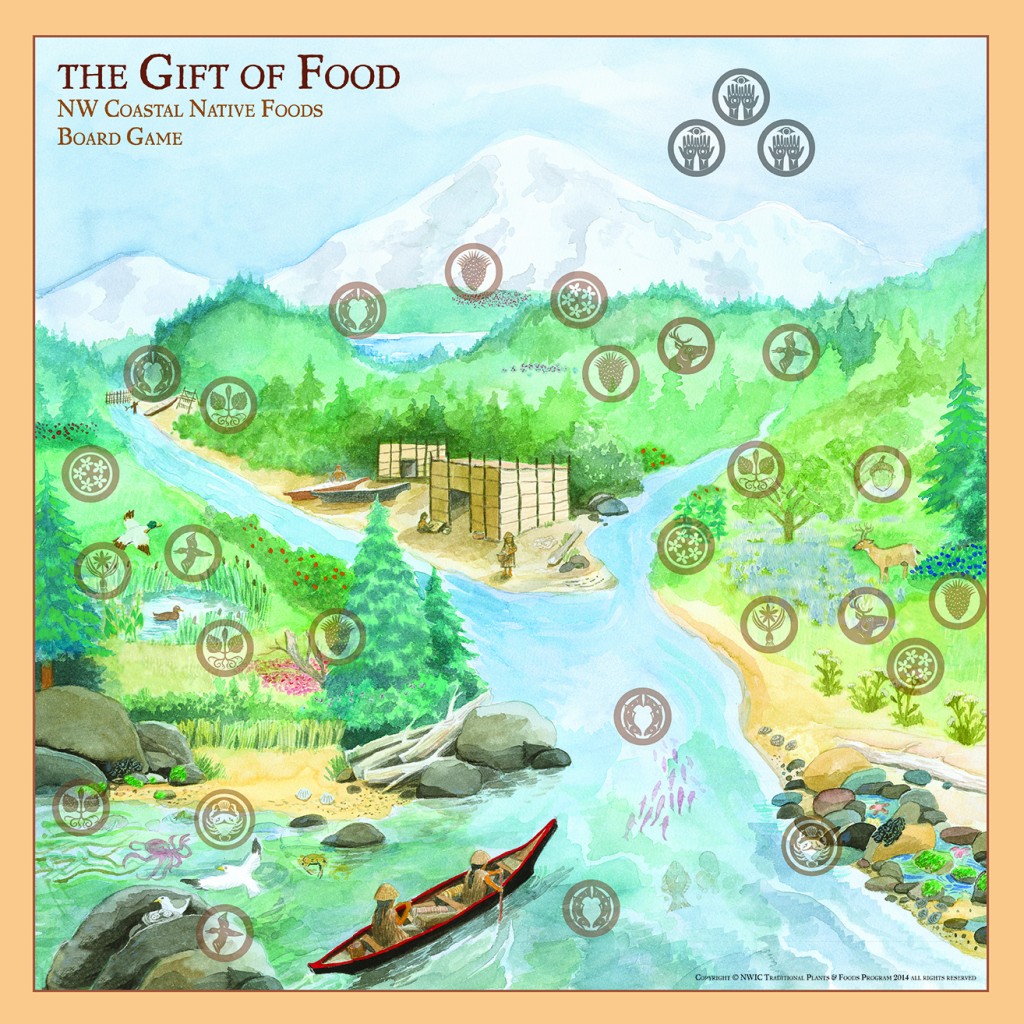
The player’s village site is along the river—a pathway that connects families to different ecosystems and distant villages. Fish such as salmon and eulachon migrate from their ancestral streams down the river to the sea and return to spawn, while others reside in the river year-round. Specialized fishing techniques and permanent structures including weirs, nets, and traps increase a player’s chances of catching fish and also help with monitoring and maintaining fish runs. The estuary where the river meets the sea is a critical habitat for young salmon, herring, and other animals such as ducks and seal. The connections between land and all forms of life are thus represented by the game mechanics and the teachings reinforced through gameplay.
There are three modes of gameplay—Full Circle, Potlatch, and Seasonal. Players can choose which mode is best depending on how much time they have to play or if they want to focus on a particular season or experience. In Full Circle Mode, players start with Spring and then play through Summer, Autumn, and Winter. At the end of Winter, players exchange Stewardship Bonus Tokens for Food Gift or Medicine Tokens. The player with the greatest diversity of Food Gifts in their Wellbeing wins. If tied, the player with the greatest total number of Tokens in their Basket wins. In Potlatch Mode, players play through Spring, Summer, and Autumn and stop before Winter for a Potlatch Celebration. At the end of Autumn, players exchange Stewardship Bonus Tokens for Food Gift or Medicine Tokens. The player with the greatest diversity of Food Gifts to contribute to the Potlatch from their Basket wins. Finally, in Seasonal Mode, players only play through Spring, or both Spring and Summer. At the end of the game, players exchange Stewardship Bonus Tokens for Food Gift or Medicine Tokens. The player with the greatest diversity of Food Gifts in their Wellbeing wins. If tied, the player with the greatest diversity of Tokens in their Basket wins. In each gameplay mode, the emphasis is on the diversity of your Food Gifts rather than the total amount, thus promoting the value of balanced wellbeing over simply taking in ways that would impact the availability of Food Gifts in future seasons.
Each player takes a turn in a clockwise order after either one player is identified as the elder of the group or someone volunteers. Scenario Cards are seasonal situations in stacks of Spring, Summer, Autumn, and Winter. Each player picks one randomly shuffled seasonal Scenario Card each turn until all cards are used. The player reads the scenario and options out loud, then chooses one option and flips the Scenario Card over to experience the outcome. Scenarios involve actions including but not limited to hunting, gathering, fishing, making nets, braving storms, telling stories, and contributing to community feasts. Each Scenario has three possible outcomes. Players may gain or lose Food Gifts or Medicine, contribute Food Gifts or Medicine to other families, trade with other families, or gain a Stewardship Bonus, which is then moved to or from the Basket Mat.
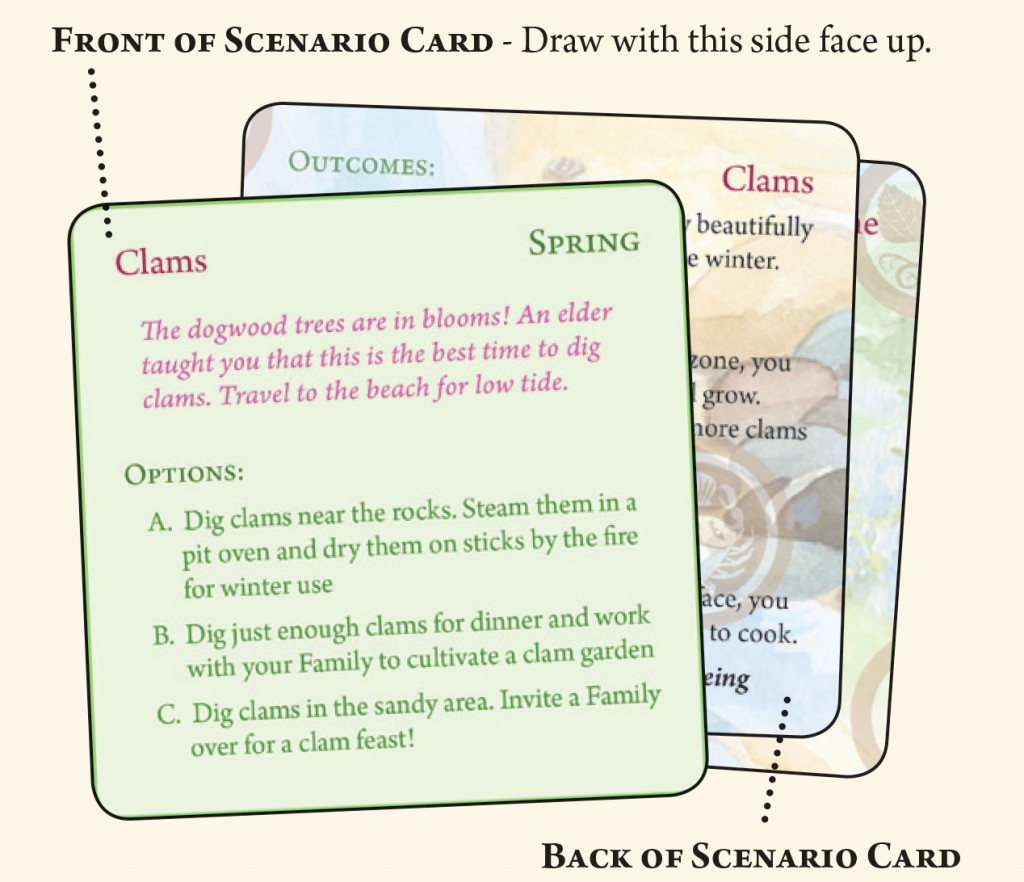
The Basket Mat includes a basket for stored Food Gifts and Medicines, a Wellbeing bar where Food Gift Tokens and Medicine Tokens represent what has been used to maintain your wellbeing, and a Stewardship Bonus slot where Stewardship Tokens are stacked until they are used to trade for Food Gifts or Medicines based on your needs. Stewardship Bonus Tokens represent ways that you care for the land and promote the abundance and diversity of native foods. They are awarded to you based on your actions during Scenarios. At the end of the game, you exchange your Stewardship Bonus Tokens for any Food Gift Tokens. The player with the most Stewardship Bonus Tokens gets to choose Tokens first. Thus, while gameplay is determined by choices made during Scenarios, there is also the possibility of a random element where players can shift the game by diversifying their Food Gifts on their Basket Mat before the winner is determined.
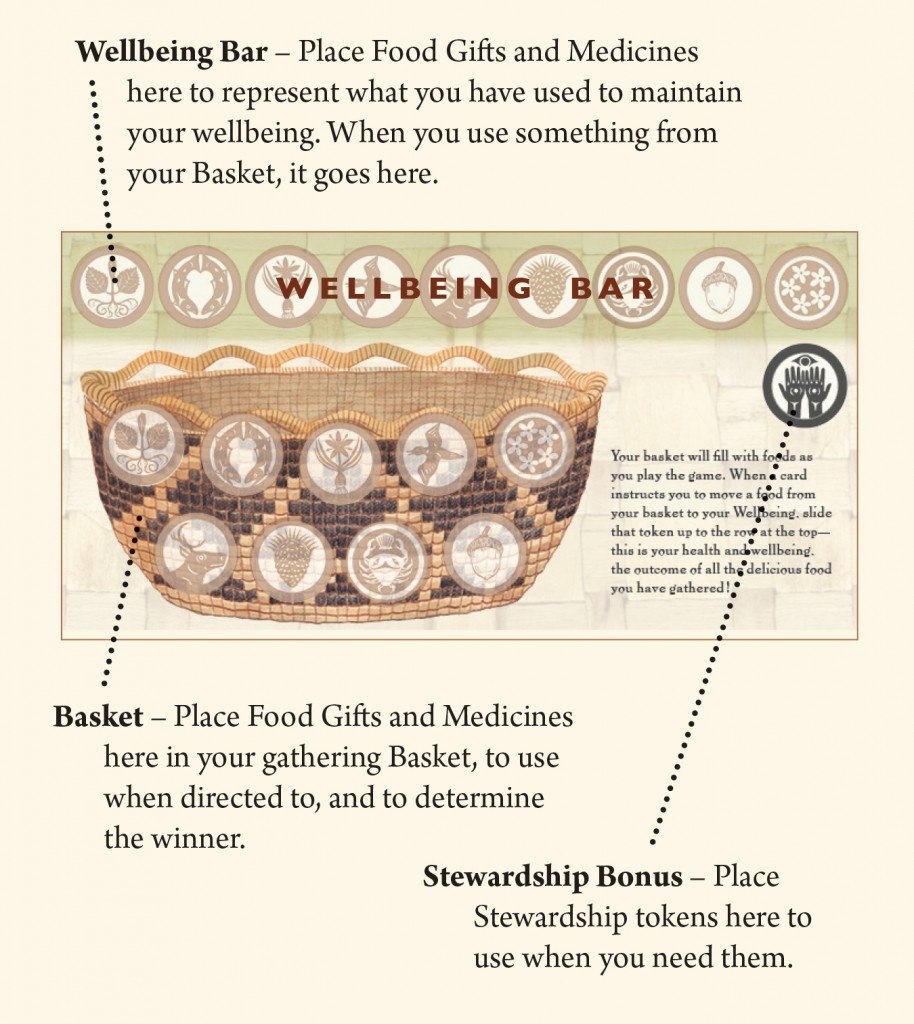
Future Work
The Gift of Food offers a strong model for the design and development process of an Indigenous board game intended to pass on community teachings. Although this board game specifically focuses on foods, medicines, land, and water, there are many other possibilities to be expressed. For example, Cree game designer Janelle Pewapsconias developed an Indigenous version of Game of Life that is currently being used in youth workshops. Board games are exciting spaces that bring players together across generations, and emerging companies such as Neeched Up Games5 and Native Teaching Aids6 promise to expand options for Indigenous players as well as welcome non-Indigenous players to experience unique gameplay developed by Indigenous designers. As Indigenous communities look for ways to revitalize and pass on teachings, board games made with a genuinely collaborative development process with Indigenous creatives and community partners prove to be an active intergenerational space for expressing Indigenous ways of knowing.
—
Featured image courtesy of the Northwest Indian College, licensed under CC BY.
—
Elizabeth LaPensée, PhD expresses herself through writing, design, and art in games, comics, and animation. She is Anishinaabe, Métis, and Irish, which informs the emphasis of her work. Most recently, she designed and programmed Invaders (2015), a remix of the arcade classic Space Invaders inspired from art by Steven Paul Judd. She also designed The Gift of Food (2014), a board game for the Northwest Indian College about Northwest Native traditional foods. Continuing her work with communities, she co-designed Tulalip Tribes: Connected to the Land: Gathering Native Foods (2014), a suite of games about Tulalip traditional foods for the Oregon Museum of Science and Industry. Her dissertation in Interactive Arts and Technology from Simon Fraser University in British Columbia shares experiences from the Indigenous social impact game Survivance (2011), which encourages ongoing healing through storytelling and creating art. Continuing this work in wellbeing, she is currently the Postdoctoral Associate for the University of Minnesota’s Research for Indigenous Community Health Center.

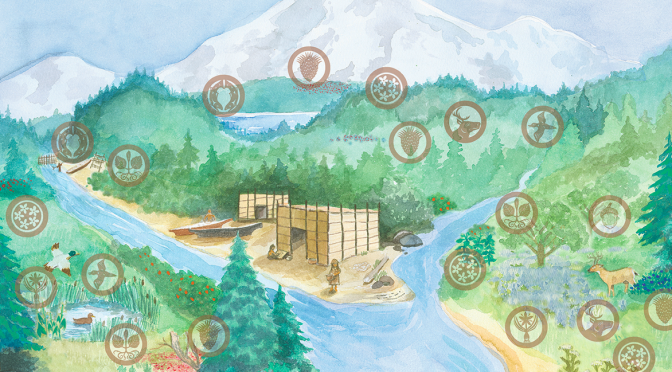
This looks wonderful! Will it be made available for crowdfunding so others can support and play it?
Thank you for your interest! The game is currently only played within Pacific Northwest communities but the core design is open source.
Hi! I wanted to say that I’m really impressed with the approach you take to game design. It’s really refreshing. I write a board game blog called The Daily Worker Placement and amongst the writing staff we’ve often discussed the misappropriation of different cultures in games. I would love to some day interview you for the site if you ever had interest. Thanks and keep up the great work!
Thank you so much! It would be great to discuss this with you. I also recommend checking out Greg Loring-Albright’s article “The First Nations of Catan: Practices in Critical Modification” also on Analog Game Studies (see http://analoggamestudies.org/2015/11/the-first-nations-of-catan-practices-in-critical-modification/).
Although not a board game, Allen Turner’s tabletop game Ehdrigohr is an incredible example of Indigenous game design that shows how culture can be integrated into games meaningfully (see http://indiancountrytodaymedianetwork.com/2015/06/17/want-american-indian-dungeons-dragons-try-ehdrigohr-160759).
I love this! I would like to buy one for my community? Is it possible I am from Komoks First Nation. Thank you for the share
I would like one to use with my gdau.who ..a local teacher..and our cultural program.m